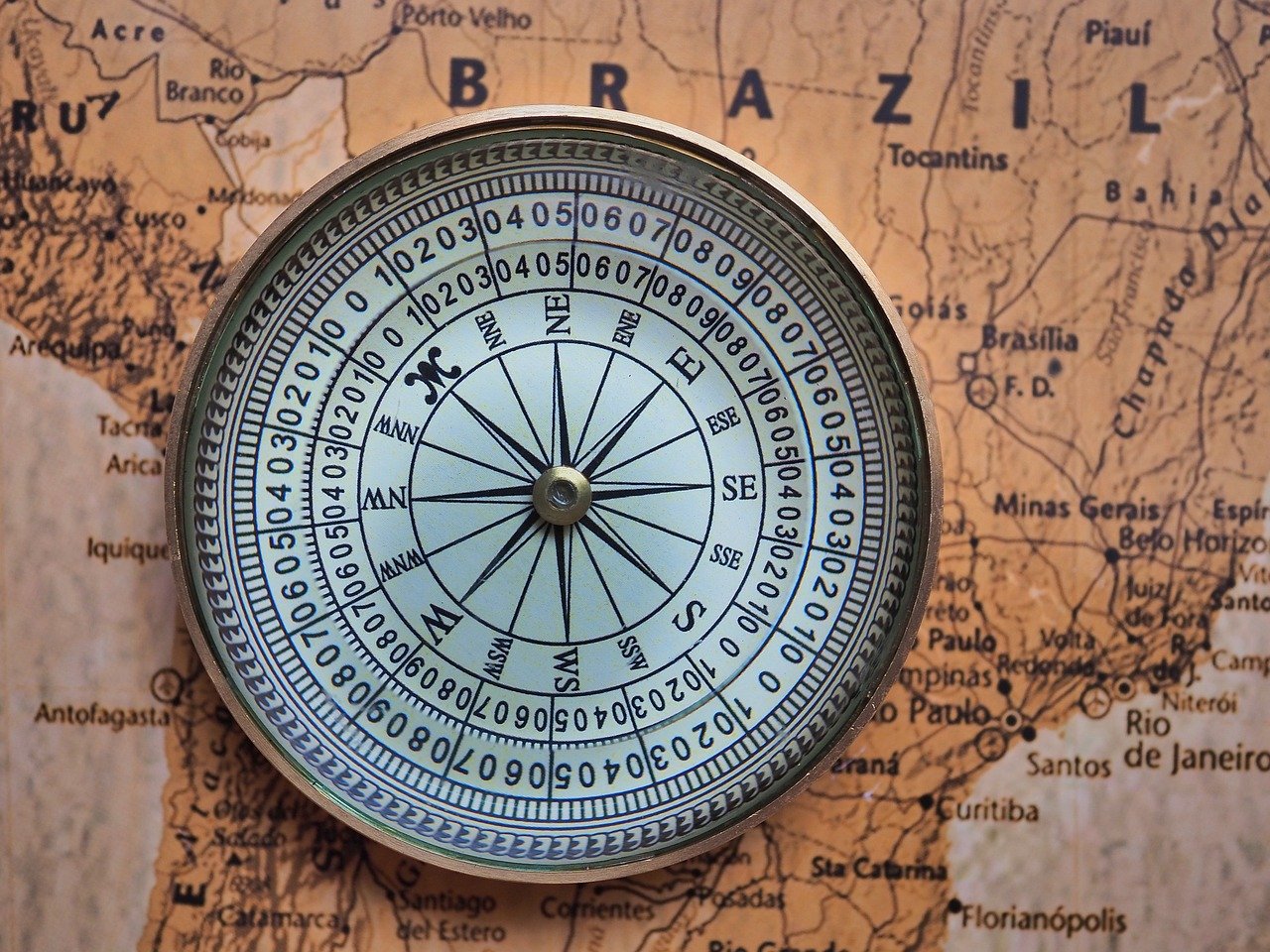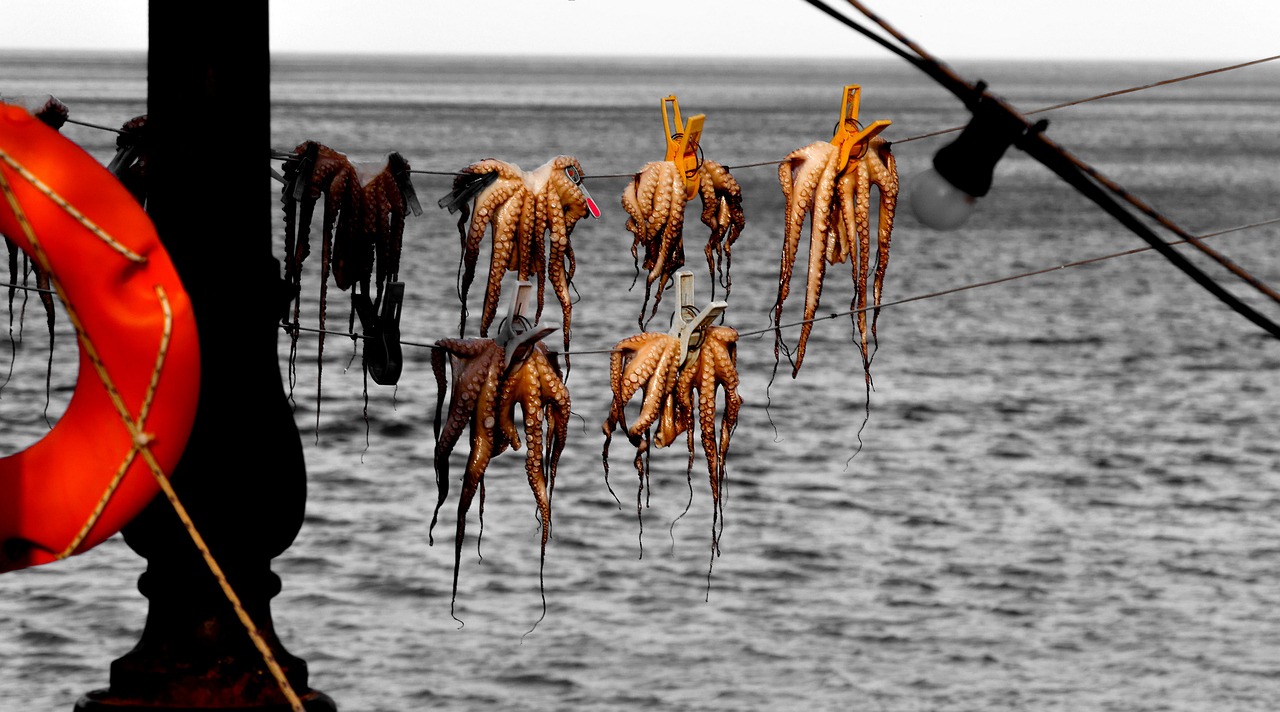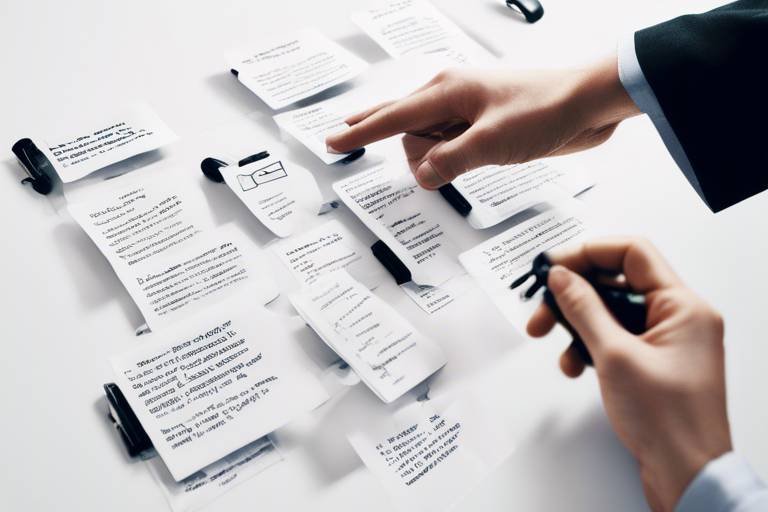How to Use Concept Mapping in Research Design
In the vast world of research, clarity is your best friend. Imagine diving into a sea of complex ideas and theories without a map—overwhelming, right? This is where concept mapping comes into play. It's not just a tool; it's a lifeline for researchers looking to navigate their thoughts and ideas effectively. Concept mapping allows you to visualize relationships between concepts, making it easier to see the big picture. Think of it as a roadmap that guides you through the intricate paths of research design, ensuring you don’t get lost along the way.
By utilizing concept mapping, researchers can enhance their understanding of the topic at hand. It’s like creating a visual diary of your thoughts, where each concept is a chapter, and the connections between them tell a story. This approach not only organizes your ideas but also highlights areas that may need further exploration. For instance, if you're working on a project about climate change, a concept map can help you visually connect various factors like greenhouse gases, renewable energy, and policy implications. This interconnectedness fosters a deeper understanding and opens up new avenues for inquiry.
Moreover, concept mapping is a powerful technique that transcends disciplinary boundaries. Whether you're in the fields of social science, natural science, or even the humanities, this method can be tailored to suit your specific research needs. It encourages creativity and innovation by prompting researchers to think critically about how different concepts relate to one another. So, if you’re ready to elevate your research design, grab your markers or open your favorite digital mapping tool, and let’s explore how to make the most of concept mapping!
At its core, concept mapping is about making connections. Picture this: you’re brainstorming for a research project, and your ideas are scattered all over the place. Concept mapping helps you gather those thoughts and arrange them in a meaningful way. It’s like assembling a puzzle where each piece represents a different concept, and when put together, they create a cohesive picture of your research focus.
When you create a concept map, you start with a central idea—this is your main research question or hypothesis. From there, you branch out into related concepts, drawing lines to illustrate how they connect. This visual representation not only aids in comprehension but also serves as a reference point throughout your research journey. You’ll find that as you delve deeper into your topic, your concept map evolves, reflecting new insights and discoveries.
Utilizing concept mapping in research design offers numerous advantages, such as improved clarity, better organization of thoughts, and the ability to identify gaps in knowledge or areas needing further exploration. When you visualize your ideas, you can see which concepts are well-developed and which ones need more attention. This clarity can significantly enhance your research process, making it more efficient and focused.
One of the most significant benefits of concept mapping is its ability to enhance critical thinking. As you create your map, you’re prompted to analyze the relationships between different concepts. This process encourages you to ask questions like, "How does this idea relate to that one?" or "What assumptions am I making?" By fostering a deeper understanding of these connections, you’re more likely to develop innovative approaches to problem-solving in your research projects.
The visual nature of concept maps aids in memory retention and information recall. When you see information laid out graphically, it’s much easier to remember complex relationships and ideas. Think of it as a mental cheat sheet that you can refer back to throughout your research journey. This way, you won't forget important connections or insights that could shape your findings.
Concept maps also serve as effective tools for collaboration among research teams. When multiple minds come together, it’s crucial to visualize collective ideas to ensure everyone is aligned with the project objectives and methodologies. A concept map can act as a central hub where team members can contribute their insights and see how their ideas fit into the larger picture. This not only fosters teamwork but also enriches the research process with diverse perspectives.
Concept mapping can be applied across various research disciplines, helping researchers outline hypotheses, design methodologies, and visualize data collection processes for a more structured approach. For instance, in a qualitative study, a concept map can help you organize themes and sub-themes, making it easier to identify patterns in your data. In quantitative research, it can assist in mapping out variables and their relationships, providing a clear framework for analysis.
Creating a concept map involves several key steps, including identifying the main idea, organizing related concepts, and illustrating connections to provide a comprehensive overview of the research topic. Start by writing down your main idea in the center of a blank page or digital canvas. Then, branch out into related concepts, drawing lines to connect them. Don’t be afraid to rearrange and refine your map as your understanding of the topic evolves.
Selecting appropriate tools for building concept maps can enhance the mapping process. You can opt for digital software like MindMeister or traditional pen-and-paper methods, depending on your personal preference. Each tool has its benefits, so choose one that feels comfortable and intuitive for you.
Regularly reviewing and refining your concept map ensures it remains relevant and accurate. As your research progresses, new insights may emerge, prompting you to adapt your design. This iterative process keeps your research dynamic and responsive to change.
- What is concept mapping? Concept mapping is a visual representation technique that helps organize and structure ideas, making it easier to understand relationships between concepts.
- How can concept mapping improve research design? It enhances clarity, fosters critical thinking, aids memory retention, and facilitates collaboration among research teams.
- What tools are available for creating concept maps? You can use digital software like MindMeister or traditional methods like pen-and-paper to create concept maps.
- Is concept mapping applicable to all research disciplines? Yes, concept mapping can be tailored to suit various research fields, including social sciences, natural sciences, and the humanities.

Understanding Concept Mapping
This article explores the significance of concept mapping in research design, outlining its benefits, techniques, and applications to enhance clarity and organization in research processes.
Concept mapping is more than just a trendy buzzword in the world of research; it's a powerful visual representation technique that helps researchers organize and structure their ideas effectively. Imagine trying to navigate a dense forest without a map—you might get lost or miss out on key landmarks. Similarly, concept mapping serves as a roadmap for researchers, guiding them through complex ideas and allowing them to visualize connections between various concepts in their research design.
At its core, concept mapping involves creating a diagram that illustrates relationships between ideas, concepts, or data. This process not only enhances comprehension but also aids in identifying how different elements interact within a research context. For instance, if you're studying the impact of social media on mental health, a concept map can help you visualize how various factors—like age, frequency of use, and type of content—interconnect and influence each other.
One of the most appealing aspects of concept mapping is its versatility. Researchers from various disciplines can leverage this technique to:
- Outline hypotheses
- Design methodologies
- Visualize data collection processes
This adaptability makes concept mapping an invaluable tool, whether you're diving into the depths of scientific research or exploring the nuances of social science.
Furthermore, the process of creating a concept map encourages researchers to think critically about their work. As you draw connections and relationships between ideas, you may uncover gaps in your knowledge or areas that require further exploration. This reflective practice not only deepens your understanding but also leads to more innovative approaches in your research projects.
In summary, concept mapping is a dynamic tool that enhances clarity and organization in research design. By visually representing ideas and their interconnections, researchers can navigate complex topics more effectively, ultimately leading to more robust and insightful research outcomes.
Utilizing concept mapping in research design offers numerous advantages, such as improved clarity, better organization of thoughts, and the ability to identify gaps in knowledge or areas needing further exploration.
Concept mapping encourages critical thinking by prompting researchers to analyze relationships between concepts, fostering deeper understanding and innovative approaches to problem-solving in their research projects.
The visual nature of concept maps aids in memory retention and information recall, making it easier for researchers to remember complex relationships and ideas throughout their research journey.
Concept maps serve as effective tools for collaboration among research teams, allowing members to visualize collective ideas and ensure everyone is on the same page regarding project objectives and methodologies.
Concept mapping can be applied across various research disciplines, helping researchers outline hypotheses, design methodologies, and visualize data collection processes for a more structured approach.
Creating a concept map involves several key steps, including identifying the main idea, organizing related concepts, and illustrating connections to provide a comprehensive overview of the research topic.
Selecting appropriate tools for building concept maps can enhance the mapping process, with options ranging from digital software to traditional pen-and-paper methods, catering to different preferences and needs.
Regularly reviewing and refining the concept map ensures it remains relevant and accurate, allowing researchers to adapt their designs based on new insights or changing research directions.
What is concept mapping?
Concept mapping is a visual technique used to organize and represent knowledge, showing relationships between different concepts.
How can concept mapping benefit my research?
It enhances clarity, improves organization, and helps identify gaps in knowledge, leading to a more structured approach to research.
Can I use concept mapping in any research discipline?
Absolutely! Concept mapping is versatile and can be applied across various fields, including science, social science, and humanities.
What tools can I use for concept mapping?
You can use digital software like MindMeister or traditional methods like pen and paper, depending on your preference.

Benefits of Concept Mapping
Utilizing concept mapping in research design offers numerous advantages that can significantly enhance the overall quality and effectiveness of your research projects. By visually organizing your thoughts and ideas, concept mapping allows you to see the bigger picture while also paying attention to the intricate details. One of the most prominent benefits is the improved clarity it brings to complex topics. When you're knee-deep in research, it's easy to get lost in the weeds. Concept maps act as a guiding light, illuminating the connections between various concepts and ensuring that nothing important slips through the cracks.
Moreover, concept mapping fosters a better organization of thoughts. Imagine trying to assemble a jigsaw puzzle without knowing what the final picture looks like. Frustrating, right? Concept maps provide that essential overview, helping you identify how different pieces of information fit together. This can be particularly useful when you're brainstorming hypotheses or designing methodologies. You can visually prioritize your ideas, which makes it much easier to determine where to focus your efforts.
Another significant advantage of concept mapping is its ability to highlight gaps in knowledge or areas needing further exploration. When you create a concept map, you may discover connections you hadn't thought of before or realize that certain concepts are underdeveloped. This self-assessment is crucial for any researcher aiming to produce high-quality work. The process of mapping can prompt you to ask questions like:
- What do I need to explore further?
- Which concepts are interrelated?
- Are there any assumptions that need to be challenged?
Furthermore, concept mapping enhances critical thinking. By analyzing the relationships between different concepts, researchers are encouraged to delve deeper into their subject matter. This not only fosters a deeper understanding but also opens the door to innovative approaches to problem-solving. Think of it as a mental workout; the more you engage with your concepts, the stronger your analytical skills become.
The visual nature of concept maps aids in memory retention and information recall. When you visualize information, it sticks better. This is especially important in research, where you often have to juggle multiple ideas and data points at once. A well-structured concept map can serve as a mental anchor, helping you remember complex relationships and ideas throughout your research journey.
Finally, concept maps facilitate collaboration among research teams. In a group setting, it's essential for everyone to be on the same page regarding project objectives and methodologies. Concept maps act as a shared visual tool, allowing team members to visualize collective ideas and ensure that all voices are heard. This collaborative aspect can lead to richer discussions and a more comprehensive approach to research design.

Enhancing Critical Thinking
Critical thinking is the backbone of effective research. It's not just about gathering data; it's about analyzing, evaluating, and interpreting that data in a way that leads to new insights and understanding. Concept mapping plays a pivotal role in strengthening this skill. By visually representing the relationships between different concepts, researchers are encouraged to step back and evaluate how these ideas interconnect. This process fosters a deeper understanding of the subject matter, allowing researchers to ask the right questions and challenge their assumptions.
When you create a concept map, you are essentially laying out a roadmap of your thoughts. This roadmap helps to clarify your thinking and highlights areas where your understanding may be lacking. For example, while mapping out your research topic, you might discover that certain concepts are not as well-defined as you thought. This realization can prompt you to dive deeper into those areas, ensuring that your research is comprehensive and well-rounded.
Moreover, concept mapping promotes a dynamic form of problem-solving. It encourages researchers to explore various angles and perspectives. Instead of just following a linear path, a concept map allows for a more holistic view of the research topic. This can lead to innovative solutions and approaches that might not have been considered otherwise. Think of it as a brainstorming session on paper, where every idea is connected, and the relationships between them can spark new avenues of thought.
Additionally, concept mapping can serve as a collaborative tool. When working in teams, sharing a visual representation of ideas can help facilitate discussions and ensure that everyone is on the same page. Team members can contribute their insights, leading to a richer, more diverse understanding of the research topic. This collaborative aspect not only enhances critical thinking but also fosters a sense of community among researchers, making the research process more enjoyable and productive.
In summary, enhancing critical thinking through concept mapping is about more than just organizing thoughts. It's about creating a vibrant, interconnected web of ideas that can lead to greater insights and understanding. By visualizing relationships, questioning assumptions, and collaborating with others, researchers can elevate their work and contribute to the advancement of knowledge in their respective fields.
- What is concept mapping? Concept mapping is a visual tool that helps organize and represent knowledge, showing relationships between concepts.
- How does concept mapping enhance critical thinking? It promotes analysis and evaluation of relationships between concepts, leading to deeper understanding and innovative solutions.
- Can concept mapping be used in collaborative research? Yes, it serves as an effective tool for teams to visualize collective ideas and ensure alignment on project objectives.

Visual Learning and Retention
When it comes to understanding complex information, visual learning plays a crucial role. Have you ever noticed how a well-structured diagram can make a complicated topic feel much more manageable? This is where concept mapping shines. By transforming abstract ideas into a visual format, concept maps help researchers grasp intricate relationships and hierarchies. Imagine trying to assemble a jigsaw puzzle without seeing the picture on the box; concept maps provide that essential visual guide, making it easier to see how pieces fit together.
Research shows that our brains are wired to process visuals more effectively than text alone. This means that when we engage with concept maps, we're not just passively absorbing information; we're actively enhancing our memory retention. The act of creating a map encourages us to think critically about how concepts relate to one another, leading to deeper understanding. When we visualize information, we create mental images that stick with us longer. In fact, studies suggest that people remember about 65% of visual information three days later, compared to just 10% of what they read. This stark contrast highlights the power of visual aids in learning.
Furthermore, concept maps allow researchers to categorize and prioritize information effectively. For instance, when mapping out a research topic, one can easily identify which concepts are foundational and which are more peripheral. This clarity not only aids in retention but also helps in organizing thoughts systematically. By visually laying out the connections, researchers can pinpoint areas that require further investigation or clarification. It’s like having a roadmap for your research journey, guiding you through the twists and turns of your inquiry.
To illustrate this, consider the following example of a concept map for a research project on climate change:
| Main Topic | Subtopics | Connections |
|---|---|---|
| Climate Change | Causes, Effects, Solutions | Each subtopic connects to the main topic, showing how they influence one another. |
| Causes | Greenhouse Gases, Deforestation | These causes lead to various environmental effects. |
| Effects | Rising Sea Levels, Extreme Weather | These effects impact ecosystems and human societies. |
| Solutions | Renewable Energy, Policy Changes | These solutions aim to mitigate the identified effects. |
By visualizing these connections, researchers can better understand the broad implications of their work and retain the information more effectively. So, the next time you're diving into a complex research project, remember the power of visuals! Concept maps not only enhance retention but also make the learning process more engaging and enjoyable.

Facilitating Collaboration
In the realm of research, collaboration is not just a buzzword; it’s the lifeblood that can propel projects from mere ideas to groundbreaking discoveries. Concept mapping serves as a powerful tool in this collaborative process, acting as a visual bridge that connects diverse minds and perspectives. Imagine a team of researchers, each with their own unique insights and expertise, coming together to tackle a complex problem. Without a structured approach, their ideas can easily become tangled, leading to confusion and miscommunication.
This is where concept mapping shines. By creating a visual representation of ideas, researchers can collectively see how their thoughts interlink. It’s akin to assembling a jigsaw puzzle; each piece (or idea) has its place, and when put together, they reveal a complete picture. Concept maps allow team members to pinpoint overlaps in their research questions, methodologies, and expected outcomes, ensuring that everyone is aligned toward a common goal.
Moreover, concept maps can facilitate discussions by providing a tangible reference point. During brainstorming sessions, researchers can refer back to the map to highlight areas that need further exploration or to identify any gaps in their collective understanding. This not only enhances communication but also encourages a culture of innovation where ideas can flow freely without fear of misunderstanding.
Additionally, the collaborative nature of concept mapping can lead to the emergence of new ideas. As team members visualize their thoughts, they may discover connections they hadn’t considered before. This can spark discussions that lead to innovative solutions or novel research questions. In essence, concept maps transform individual insights into a shared vision, fostering a sense of community and teamwork that is essential in research.
To illustrate the effectiveness of concept mapping in collaboration, consider the following table that outlines key benefits:
| Benefit | Description |
|---|---|
| Enhanced Communication | Provides a clear visual reference that helps team members articulate their ideas effectively. |
| Alignment of Goals | Ensures all team members are on the same page regarding project objectives and methodologies. |
| Idea Generation | Encourages brainstorming and the exploration of new concepts through visual connections. |
| Identification of Gaps | Helps pinpoint areas that require further exploration or clarification. |
In conclusion, utilizing concept mapping in collaborative research not only streamlines the process but also enhances the quality of the outcomes. By visualizing thoughts and ideas, researchers can work together more effectively, ensuring that their collective efforts lead to insightful and impactful results.
- What is concept mapping? Concept mapping is a visual technique used to organize and represent knowledge, showing the relationships between different concepts.
- How does concept mapping enhance collaboration? It provides a visual framework that helps team members communicate their ideas clearly, align their goals, and identify gaps in understanding.
- Can concept maps be used in any research discipline? Yes, concept mapping is versatile and can be applied across various fields of research, from social sciences to natural sciences.
- What tools can I use to create concept maps? There are many tools available, including digital software like MindMeister and traditional methods like pen and paper.

Applications in Research Design
Concept mapping is not just a trendy buzzword; it's a powerful tool that can revolutionize the way researchers approach their projects. Whether you're diving into social sciences, medicine, or any other field, concept mapping can help clarify your research design and streamline your process. So, how does this visual technique fit into the intricate puzzle of research? Let’s break it down.
First off, concept mapping allows researchers to outline their hypotheses in a clear and structured manner. By visually representing your main idea and its supporting arguments, you can easily identify the relationships between different elements of your research. This not only aids in understanding but also helps in communicating your ideas effectively to others. Imagine trying to explain a complex theory without a visual aid—it's like trying to navigate a maze blindfolded. Concept maps give you that much-needed visual clarity.
Moreover, when it comes to designing methodologies, concept mapping shines brightly. It enables researchers to visualize the steps they need to take, from data collection to analysis. For instance, by creating a flowchart-like concept map, you can map out your research methods, ensuring that each step logically follows the last. This structured approach minimizes the chance of overlooking critical components, which can often happen in traditional linear planning.
Another significant application of concept mapping is in the visualization of data collection processes. Imagine you're conducting a survey. Instead of just jotting down questions in a list, you can create a concept map that links your research questions to the corresponding data collection methods and target populations. This not only helps in organizing your thoughts but also provides a comprehensive overview of your research strategy. Here's a simple example:
| Research Question | Data Collection Method | Target Population |
|---|---|---|
| What factors influence student performance? | Survey | High school students |
| How does technology impact learning? | Interviews | Teachers and students |
| What are the benefits of group study? | Focus Groups | College students |
This table illustrates how concept mapping can help you connect your research questions with appropriate data collection methods and target populations, creating a cohesive research design. Additionally, concept maps can be beneficial in identifying gaps in your research. When you lay out all your ideas visually, it becomes easier to spot areas that need further exploration or clarification. This proactive approach not only enhances the quality of your research but also saves time in the long run.
In essence, the applications of concept mapping in research design are vast and varied. From outlining hypotheses to designing methodologies and visualizing data collection processes, concept mapping serves as a versatile tool that can enhance the clarity and organization of your research. So, if you haven’t tried it yet, what are you waiting for? Dive in and experience the transformational power of concept mapping!
- What is concept mapping? Concept mapping is a visual representation technique that helps researchers organize and structure their ideas, enhancing comprehension and facilitating connections between various concepts.
- How can concept mapping improve my research? It improves clarity, enhances organization of thoughts, and helps identify gaps in knowledge, making your research process more efficient.
- Can I use digital tools for concept mapping? Absolutely! There are various digital tools available that make creating concept maps easy and accessible, allowing for creativity and flexibility in your research design.
- How often should I review my concept map? Regularly reviewing and refining your concept map is crucial to ensure it remains relevant and accurate as your research progresses.

Steps to Create a Concept Map
Creating a concept map is an engaging and insightful process that can significantly enhance your research design. It’s not just about drawing lines and boxes; it’s about transforming abstract ideas into a structured visual format. So, how do you go about it? Let’s break it down into manageable steps that will guide you through the creation of an effective concept map.
First and foremost, you need to identify the main idea of your research. This is the cornerstone of your concept map, the central theme around which all other concepts will revolve. Think of it as the sun in your solar system of ideas—everything else orbits around it. Once you’ve pinpointed your main idea, it’s time to branch out. Start jotting down related concepts, themes, or questions that connect to your main idea. This is where your creativity can shine, as you’ll want to explore various angles and dimensions of your research topic.
Next, organize these related concepts in a logical manner. You can categorize them into broader themes or sub-topics, creating a hierarchy that makes sense for your research. It’s like building a tree: the trunk represents your main idea, while the branches symbolize the various sub-concepts. This organization not only clarifies your thoughts but also helps you visualize how different concepts interlink with one another.
Once you have your main idea and related concepts laid out, it’s time to illustrate the connections. Use lines or arrows to demonstrate how these concepts relate to each other. This step is crucial because it visually represents the relationships and hierarchies within your research. Don’t hesitate to add labels to these connections to clarify the nature of the relationships. For instance, you might indicate whether one concept supports another, or if they are in opposition.
As you create your concept map, consider using appropriate tools that cater to your style. Whether you prefer digital tools like MindMeister or traditional pen-and-paper methods, choose what feels comfortable for you. The right tools can enhance your mapping process, making it more enjoyable and efficient. If you’re working in a team, collaborative software can also be a great choice to ensure everyone’s input is captured.
Lastly, remember that a concept map is a living document. It’s important to review and refine your map regularly. As you gather more information and insights during your research journey, your concept map should evolve to reflect these changes. This iterative process not only keeps your research relevant but also allows you to adapt your design based on new findings or shifts in your research direction.
In summary, creating a concept map involves:
- Identifying the main idea
- Organizing related concepts
- Illustrating connections
- Choosing the right tools
- Reviewing and refining regularly
By following these steps, you’ll be well on your way to crafting a concept map that not only enhances your understanding of your research topic but also serves as a valuable tool throughout your research process.
Q: What is the purpose of a concept map in research?
A: A concept map helps researchers visualize relationships between ideas, enhancing clarity and organization in their research design.
Q: Can I use software to create a concept map?
A: Yes! There are various digital tools available, such as MindMeister and Lucidchart, that can help you create concept maps easily.
Q: How often should I update my concept map?
A: Regular updates are essential, especially as you gather new information or insights. This ensures your map remains relevant and accurate.
Q: Is there a specific format I should follow for my concept map?
A: There’s no one-size-fits-all format. The key is to create a structure that makes sense for your research and clearly illustrates the relationships among concepts.

Choosing the Right Tools
When it comes to concept mapping, selecting the right tools can make a world of difference. Imagine trying to build a house without the proper equipment; it would be frustrating, right? The same applies to creating effective concept maps. Whether you prefer the tactile feel of pen and paper or the convenience of digital platforms, the choice of tools can significantly impact your mapping experience.
There are numerous options available to suit various preferences and needs. For those who thrive on the traditional approach, a simple notebook and colored markers can do wonders. The act of writing by hand often helps in cementing ideas in your mind. Plus, the visual appeal of different colors can enhance your creativity and make the mapping process more enjoyable.
On the other hand, if you lean towards a more modern approach, digital tools can offer features that streamline the mapping process. Applications like MindMeister, XMind, and Coggle provide user-friendly interfaces that allow for easy adjustments and sharing with team members. These platforms often come with the ability to add multimedia elements, hyperlinks, and even collaborative features that can enhance group projects.
Here’s a quick comparison of some popular tools:
| Tool | Type | Features |
|---|---|---|
| MindMeister | Digital | Real-time collaboration, templates, and task management |
| XMind | Digital | Professional templates, brainstorming mode, and Gantt chart view |
| Coggle | Digital | Simple interface, unlimited image uploads, and collaborative editing |
| Traditional Pen & Paper | Analog | Personal touch, no tech required, and customizable layout |
Ultimately, the best tool is one that resonates with your personal style and enhances your ability to visualize complex relationships. Don’t hesitate to experiment with different tools until you find the one that feels just right. Remember, the goal is to create a map that not only helps you understand your research better but also excites you about the journey ahead!

Reviewing and Refining the Map
Once you've created your concept map, it's crucial to review and refine it regularly. Think of your concept map as a living document; it should evolve as your research progresses. Just like a gardener tends to their plants, you need to nurture your map to ensure it remains relevant and accurate. This process can significantly enhance the quality of your research design.
Start by assessing the clarity of your connections. Are the relationships between concepts clearly defined? If you find any vague links, consider revising them for clarity. Additionally, ask yourself if the main idea is still relevant to your research objectives. Sometimes, as you delve deeper into your study, the focus may shift, and your map should reflect that.
Another important aspect is to incorporate feedback from peers or mentors. Sharing your concept map with others can provide fresh perspectives and highlight areas that might need further elaboration. They might spot gaps in your logic or suggest new connections that you hadn't considered. This collaborative effort can lead to a more robust and comprehensive research design.
As you review your concept map, keep an eye out for any emerging themes or patterns. These insights can be invaluable, guiding you toward new avenues of exploration. Don't hesitate to make adjustments or add new concepts that arise during your research journey. Remember, flexibility is key.
Lastly, document your changes. Keeping a record of how your concept map has evolved can be beneficial for future reference. It not only helps you track your research progress but also allows you to reflect on your thought process over time. This self-reflection can enhance your critical thinking skills and improve your overall research methodology.
- What is a concept map? A concept map is a visual tool that helps organize and represent knowledge, illustrating relationships between different concepts.
- How often should I review my concept map? It's advisable to review your concept map regularly, especially after significant research milestones or when new insights emerge.
- Can I use digital tools for concept mapping? Yes! There are various digital tools available that can help you create and refine concept maps efficiently.
- What if I don't know how to start my concept map? Begin with your main idea and branch out to related concepts. Don't worry about perfection; just get your thoughts down first.
Frequently Asked Questions
- What is concept mapping?
Concept mapping is a visual technique used to organize and represent knowledge. It helps researchers clarify their thoughts and see the relationships between different concepts, making it easier to structure their research design.
- How does concept mapping improve research clarity?
By visually laying out ideas and their connections, concept mapping enhances clarity in research. It allows researchers to identify gaps in their understanding and organize their thoughts in a way that highlights the flow of information.
- Can concept mapping enhance critical thinking?
Absolutely! Concept mapping encourages researchers to analyze and evaluate the relationships between different ideas, which fosters deeper understanding and innovative problem-solving approaches in their research projects.
- What are the benefits of using concept maps for collaboration?
Concept maps are fantastic for collaboration as they provide a visual representation of collective ideas. This ensures that all team members are aligned on project objectives and methodologies, leading to more effective teamwork.
- What tools can I use to create concept maps?
There are various tools available for creating concept maps, ranging from digital software like MindMeister and Lucidchart to traditional pen-and-paper methods. The choice depends on personal preference and the specific needs of your research.
- How often should I review and refine my concept map?
It's a good practice to review and refine your concept map regularly, especially as new insights emerge or your research direction changes. This keeps your map relevant and ensures it accurately reflects your evolving understanding of the topic.
- In what research disciplines can concept mapping be applied?
Concept mapping can be applied across various research disciplines, including social sciences, education, healthcare, and more. It helps in outlining hypotheses, designing methodologies, and visualizing data collection processes.

















